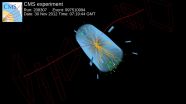(Press-News.org) Two experiments at the Large Hadron Collider at the European Organization for Nuclear Research (CERN) in Geneva, Switzerland, have combined their results and observed a previously unseen subatomic process.
As published in the journal Nature this week, a joint analysis by the CMS and LHCb collaborations has established a new and extremely rare decay of the Bs particle (a heavy composite particle consisting of a bottom antiquark and a strange quark) into two muons. Theorists had predicted that this decay would only occur about four times out of a billion, and that is roughly what the two experiments observed.
"It's amazing that this theoretical prediction is so accurate and even more amazing that we can actually observe it at all," said Syracuse University Professor Sheldon Stone, a member of the LHCb collaboration. "This is a great triumph for the LHC and both experiments."
LHCb and CMS both study the properties of particles to search for cracks in the Standard Model, our best description so far of the behavior of all directly observable matter in the universe. The Standard Model is known to be incomplete since it does not address issues such as the presence of dark matter or the abundance of matter over antimatter in our universe. Any deviations from this model could be evidence of new physics at play, such as new particles or forces that could provide answers to these mysteries.
"Many theories that propose to extend the Standard Model also predict an increase in this Bs decay rate," said Fermilab's Joel Butler of the CMS experiment. "This new result allows us to discount or severely limit the parameters of most of these theories. Any viable theory must predict a change small enough to be accommodated by the remaining uncertainty."
Researchers at the LHC are particularly interested in particles containing bottom quarks because they are easy to detect, abundantly produced and have a relatively long lifespan, according to Stone.
"We also know that Bs mesons oscillate between their matter and their antimatter counterparts, a process first discovered at Fermilab in 2006," Stone said. "Studying the properties of B mesons will help us understand the imbalance of matter and antimatter in the universe."
That imbalance is a mystery scientists are working to unravel. The big bang that created the universe should have resulted in equal amounts of matter and antimatter, annihilating each other on contact. But matter prevails, and scientists have not yet discovered the mechanism that made that possible.
"The LHC will soon begin a new run at higher energy and intensity," Butler said. "The precision with which this decay is measured will improve, further limiting the viable Standard Model extensions. And of course, we always hope to see the new physics directly in the form of new particles or forces."
This discovery grew from analysis of data taken in 2011 and 2012 by both experiments. Scientists also saw some evidence for this same process for the Bd particle, a similar particle consisting of a bottom antiquark and a down quark. However, this process is much more rare and predicted to occur only once out of every 10 billion decays. More data will be needed to conclusively establish its decay to two muons.
INFORMATION:
The U.S. Department of Energy Office of Science provides funding for the U.S. contributions to the CMS experiment. The National Science Foundation provides funding for the U.S. contributions to the CMS and LHCb experiments. Together, the CMS and LHCb collaborations include more than 4,500 scientists from more than 250 institutions in 44 countries.
Fermilab is America's premier national laboratory for particle physics and accelerator research. A U.S. Department of Energy Office of Science laboratory, Fermilab is located near Chicago, Illinois, and operated under contract by the Fermi Research Alliance LLC. Visit Fermilab's website at http://www.fnal.gov and follow us on Twitter at @Fermilab.
The DOE Office of Science is the single largest supporter of basic research in the physical sciences in the United States and is working to address some of the most pressing challenges of our time. For more information, please visit science.energy.gov.
The National Science Foundation (NSF) is an independent federal agency that supports fundamental research and education across all fields of science and engineering. In fiscal year (FY) 2015, its budget is $7.3 billion. NSF funds reach all 50 states through grants to nearly 2,000 colleges, universities and other institutions. Each year, NSF receives about 48,000 competitive proposals for funding, and makes about 11,000 new funding awards. NSF also awards about $626 million in professional and service contracts yearly.
CERN, the European Organization for Nuclear Research, is the world's leading laboratory for particle physics. It has its headquarters in Geneva. At present, its Member States are Austria, Belgium, Bulgaria, the Czech Republic, Denmark, Finland, France, Germany, Greece, Hungary, Israel, Italy, the Netherlands, Norway, Poland, Portugal, Slovakia, Spain, Sweden, Switzerland and the United Kingdom. Romania is a Candidate for Accession. Serbia is an Associate Member in the pre-stage to Membership. India, Japan, the Russian Federation, the United States of America, Turkey, the European Union, JINR and UNESCO have Observer Status.
Benign prostatic hyperplasia (BPH) -- or, simply, prostate enlargement -- is one of the most common diseases of aging among men in the United States. In fact, by the time they hit 80 or above, upwards of 90 percent of all men in the U.S. experience some degree of prostate enlargement. And of those, 40 percent require medical treatment.
Despite the fact that the disease impacts so many people and carries with it a huge price tag -- estimated at tens of billions of dollars per year in medical expenses and lost wages, among other costs -- the factors that contribute to BPH ...
For the first time, satellite mapping of Latin America shows that the continent's agricultural expansion has waned in the wake of the global economic downturn, according to UBC research.
"Nearly every agricultural region across Latin America slowed down in expansion from 2007 to 2013, compared to the previous six years," says Jordan Graesser, the study's lead author. Graesser is a visiting international student at UBC's Liu Institute for Global Issues and the Institute for Resources, Environment and Sustainability.
The study, recently published in Environmental Research ...
ITHACA, N.Y. -- If you're planning to fly over the holiday, plan to drink some tomato juice. While examining how airplane noise affects the palate, Cornell University food scientists found sweetness suppressed and a tasty, tender tomato surprise: umami.
A Japanese scientific term, umami describes the sweet, savory taste of amino acids such as glutamate in foods like tomato juice, and according to the new study, in noisy situations -- like the 85 decibels aboard a jetliner -- umami-rich foods become your taste bud's best buds.
"Our study confirmed that in an environment ...
PITTSBURGH -- A research team led by the University of Pittsburgh's Jeremy Levy has discovered electrons that can "swing dance." This unique electronic behavior can potentially lead to new families of quantum devices.
Superconductors, materials that permit electrical current to flow without energy loss, form the basis for magnetic resonance imaging devices as well as emerging technologies such as quantum computers. At the heart of all superconductors is the bunching of electrons into pairs.
Levy, Distinguished Professor of Physics and Pittsburgh Quantum Institute director, ...
The type of perfectionist who sets impossibly high standards for others has a bit of a dark side. They tend to be narcissistic, antisocial and to have an aggressive sense of humor. They care little about social norms and do not readily fit into the bigger social picture. So says Joachim Stoeber of the University of Kent in the UK, who compared the characteristics of so-called other-orientated perfectionists against those of perfectionists who set the bar extremely high for themselves. The study is published in Springer's Journal of Psychopathology and Behavioral Assessment.
Perfectionism ...
Typhoon Dolphin (strengthened overnight on 5/12 from Tropical Storm status) formed south of Pohnpei in the western Pacific Ocean on May 7, 2015. Dolphin's power has oscillated from a weak tropical depression to typhoon intensity over the past five days. Dolphin is now an intensifying typhoon headed westward.
The GPM core observatory satellite flew over Dolphin on May 12, 2015 at 2301 UTC. At that time Dolphin's wind speeds were estimated at about 65 kts (75 mph). Rainfall collected by GPM's Microwave Imager (GMI) showed that rain was falling at a rate of over 47 mm (1.9 ...
As murder mysteries go, it's a big one: how do galaxies die and what kills them? A new study, published today in the journal Nature, has found that the primary cause of galactic death is strangulation, which occurs after galaxies are cut off from the raw materials needed to make new stars.
Researchers from the University of Cambridge and the Royal Observatory Edinburgh have found that levels of metals contained in dead galaxies provide key 'fingerprints', making it possible to determine the cause of death.
There are two types of galaxies in the Universe: roughly half ...
If you walk into a dark room, you can still find your way to the light switch. That's because your brain keeps track of landmarks and the direction in which you are moving. Fruit flies also boast an internal compass that works when the lights go out, scientists at the Howard Hughes Medical Institute's Janelia Research Campus have discovered. Their findings suggest that dissecting how fruit flies navigate through the world could help researchers understand how humans and other mammals achieve that task.
In our brains, several kinds of neurons help us get and keep our bearings. ...
Humans concerned about climate change are working to find ways of capturing excess carbon dioxide (CO2) from the atmosphere and sequestering it in the Earth. But Nature has its own methods for the removal and long-term storage of carbon, including the world's river systems, which transport decaying organic material and eroded rock from land to the ocean.
While river transport of carbon to the ocean is not on a scale that will bail humans out of our CO2 problem, we don't actually know how much carbon the world's rivers routinely flush into the ocean - an important piece ...
Antipsychotic medication use during pregnancy does not put women at additional risk of developing gestational diabetes, hypertensive disorders or major blood clots that obstruct circulation, according to a new study led by researchers at Women's College Hospital and the Institute for Clinical Evaluative Sciences (ICES).
The study, published today in BMJ, is the largest to date to examine possible links between newer antipsychotic medications -- such as quetiapine, olanzapine and risperidone -- and medical conditions that often develop during pregnancy or with use of older ...




